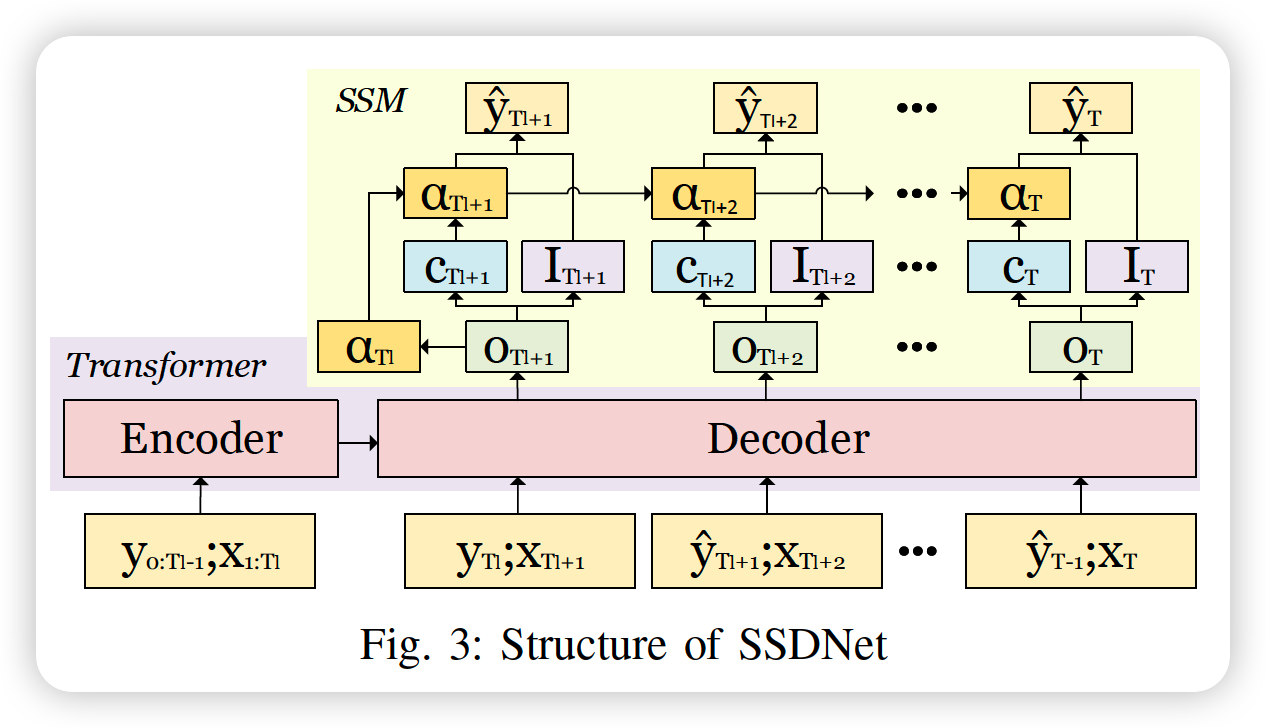SSDNet : State Space Decomposition NN for TS Forecasting (2021)
Contents
- Abstract
- Problem Formulation
- SSDNet
- Network Architecture
- Loss Function
0. Abstract
SSDNet = (1) Transformer + (2) SSM
-
probabilistic & interpretable forecasts
( including trend & seasonality components )
Use of Transformer
- to learn temporal patterns
- to estimate the parameters of SSM directly
1. Problem Formulation
3 tasks
- (1) solar power forecasting
- (2) electricity demand forecasting
- (3) exchange rate forecasting
Input (Notation)
- (1) \(N\) univariate TS : \(\left\{\mathbf{Y}_{i, 1: T_{l}}\right\}_{i=1}^{N}\)
- \(\mathbf{Y}_{i, 1: T_{l}}:=\left[y_{i, 1}, y_{i, 2}, \ldots, y_{i, T_{l}}\right]\).
- \(y_{i, t} \in \Re\) : value of \(i\)-th TS at time \(t\)
- (2) multi-dim covariates : \(\left\{\mathbf{X}_{i, 1: T_{l}+T_{h}}\right\}_{i=1}^{N}\)
Goal
- predict \(\left\{\mathbf{Y}_{i, T_{l}+1: T_{l}+T_{h}}\right\}_{i=1}^{N}\)
SSDNet
produces a pdf of future values :
\(p\left(\mathbf{Y}_{i, T_{l}+1: T_{l}+T_{h}} \mid \mathbf{Y}_{i, 1: T_{l}}, \mathbf{X}_{i, 1: T_{l}+T_{h}} ; \Phi\right) =\prod_{t=T_{l}+1}^{T_{l}+T_{h}} p\left(y_{i, t} \mid \mathbf{Y}_{i, 1: t-1}, \mathbf{X}_{i, 1: t} ; \Phi\right)\),
2. SSDNet
2-1. Network Architecture

a) SSDNet
- (1) Transformer + (2) SSM
- 2 feed forward steps
b) traditional SSM vs SSDNet
-
SSDNet : remove random noise part
-
SSM (of SSDNet) does not process historical series directly,
rather, uses latent component generated by Transformer
c) Steps
[ Step 1 ]
- Transformer generates latent components
- this latent component is used to estimate SSM params & variance of forecast
[ Step 2 ]
- SSM takes the state vector from the previous step
- uses it to predict mean of forecast
d) Details
-
step 1) Transformer extracts latent components \(o_{t}\),
-
from time series \(y_{1: T_{l}}, x_{1: T_{t}}\)
-
\(o_{t}=f\left(y_{1: T_{l}}, x_{1: T_{t}}\right)\).
-
-
step 2) employ additive TS decomoposition model
- in the form of SSM
- \(\hat{y}_{t}\) = \(T_{t}\) + \(S_t\) + \(I_t\) ( = probability component )
- step 2) in detail :
- \(\hat{y}_{t}=z_{t}^{T} \alpha_{t}+I_{t}, \quad t=1, \ldots, T_{h}\).
- \(\alpha_{t+1}=\Gamma_{t} \alpha_{t}+c_{t}\).
- \(I_{t} \sim \mathcal{N}\left(0, \sigma_{I_{t}}^{2}\right)\).
- \(\alpha_{t} \in \Re^{s \times 1}\) : latent state vector
- it contains trend ( \(\operatorname{Tr}_{t}\) ) & seasonality ( \(S_{t}\))
- \(s\) : number of seasonality
- \(c_{t} \in \Re^{s \times 1}\) : innovation term
- allow SSDNet to learn stochastic trends with fluctuations in TS
- \(\hat{y}_{t}=z_{t}^{T} \alpha_{t}+I_{t}, \quad t=1, \ldots, T_{h}\).
e) etc
Innovation term ( \(c_t\) ) & Variance ( \(o^2_{I_t}\) )
- learnt from latent factor \(o_t\)
- \(\begin{aligned} \sigma_{I_{t}}^{2}=g_{s}\left(o_{t}\right) &=\operatorname{Softplus}\left(\operatorname{Linear}\left(o_{t}\right)\right) \\ &=\log \left(1+\exp \left(\operatorname{Linear}\left(o_{t}\right)\right)\right) \\ \end{aligned}\).
- \(\begin{aligned} c_{t}=g_{c}\left(o_{t}\right)=& \operatorname{HardSigmoid}\left(\operatorname{Linear}\left(o_{t}\right)\right)-0.5 \\ &= \begin{cases}-0.5 & \text { if } \mathrm{x} \leq-3 \\ 0.5 & \text { if } \mathrm{x} \geq+3 \\ \text { Linear }\left(\mathrm{o}_{\mathrm{t}}\right) / 6 & \text { otherwise }\end{cases} \end{aligned}\).
\(\Gamma_{t}\) and \(z_{t}\) are non-trainable and fixed for all time steps
\(\alpha_{t}=\left(\begin{array}{c} \operatorname{Tr}_{t} \\ S_{1: s-1, t} \end{array}\right), z_{t}=\left(\begin{array}{l} 1 \\ 1 \\ 0_{s-2} \end{array}\right)\).
\(\Gamma_{t}=\left(\begin{array}{ccc} 1 & 0_{s-2}^{\prime} & 0 \\ 0 & -1_{s-2}^{\prime} & -1 \\ 0_{s-2} & I_{s-2} & 0_{s-2} \end{array}\right)\).
Initial values
- \(\alpha_{0}=g_{c}\left(o_{T_{l+1}}\right)=\operatorname{HardSigmoid}\left(\operatorname{Linear}\left(o_{T_{l+1}}\right)\right)-0.5\).
f) summary
\(\hat{y}_{t} \sim \mathcal{N}\left(T r_{t}+S_{t}, \sigma_{I_{t}}^{2}\right)\).
- predictions are sampled from the distribution
- \(\rho\)-quantile output could be generated via the inverse CDF
2-2. Loss Function
-
For accurate point & probabilistic forecasts
-
combine MAE & NLL
